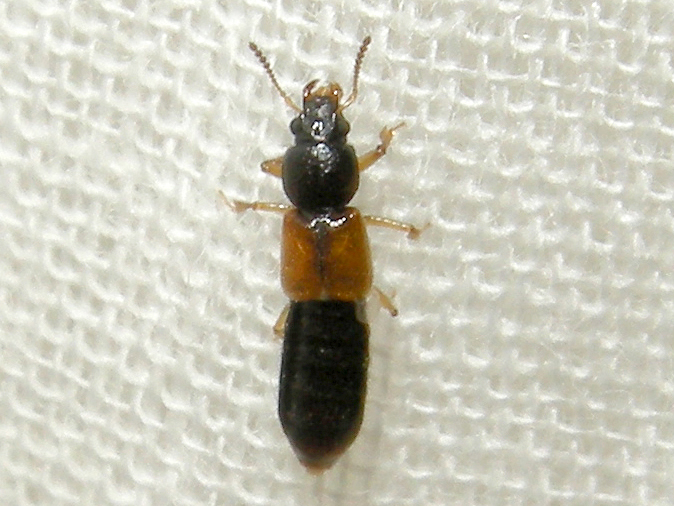Bledius opacus
I initially used Lott to key this and arrived at Bledius gallicus, but there were a couple of points where I wasn't convinced so I had another go using Duff. This time I arrived at a choice between opacus and pallipes, with Duff indicating that these two species are only safely separated on male genitalic characters. I also tried using Hackston, and this also led to opacus. Lott had sent me down the route to gallicus rather than opacus based on my interpretation of the pronotum shape, the differences in which seemed pretty subtle. Both Duff and Hackston eliminated gallicus on account of the open fore coxal fissure. Once I'd worked out what that was, which wasn't immediately obvious to me even with the diagram in Duff, this seemed pretty black-and-white which meant that gallicus was certainly wrong. Returning to the couplet where I'd therefore gone wrong using Lott, taking the alternative option took me to opacus there too. So in the end, I'm happy that it's opacus, with the caveat that according to Duff I cannot eliminate pallipes (as it was a female). So far as I know there are no records of pallipes in Norfolk, whereas I believe opacus is the species of Bledius with the most records, so at this point it seems pragmatic to assume it is opacus not pallipes.
 (1).jpg)
 (2).jpg)
 (3).jpg)
 (4).jpg)
 (18).jpg)
 (5).jpg)
 (21).jpg)
 (6).jpg)
 (7).jpg)
 (8).jpg)
 (17).jpg)
 (19).jpg)
 (20).jpg)
 (9).jpg)
 (12).jpg)
 (14).jpg)
 (10).jpg)
 (13).jpg)
 (26).jpg)
female Bledius opacus showing antennae, palps, labrum, ridges above antennal bases from above and side, pronotum, pronotal hairs, side of thorax showing position of fore coxal fissure, fore coxal fissure close-up, fore tibial spines, elytra, elytral hairs, tergites, apical tergites and spermatheca, North Elmham (Norfolk, UK), 12th June 2025
Back in 2014 I was hardly looking at beetles and certainly wasn't making any serious attempt to identify difficult species like rove beetles. Nevertheless for some reason I had a stab at this one, probably by comparing it to images on NatureSpot or some similarly unscientific approach. The best match I could find was Oxytelus laqueatus but looking back at it now I don't think that's right. Without a specimen I can't key it out, but I reckon it looks better for a Bledius species. Of those Bledius opacus seems a strong contender. I don't think that's good enough to be positive about it so I won't record it unless someone more experienced thinks it's safe to do so.

possible Bledius opacus, Bawdeswell (Norfolk, UK), 18th July 2014
